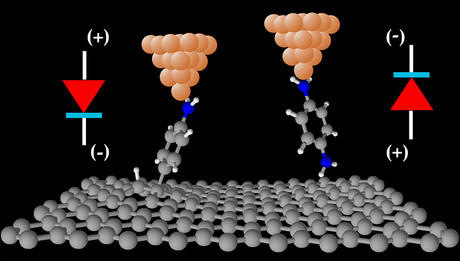Graphene electrodes benefit molecular electronic devices

An international team of researchers has revealed a new way to tune the functionality of next-generation molecular electronic devices using graphene. The results could be exploited to develop smaller, higher-performance devices for use in applications including molecular sensing, flexible electronics and energy conversion and storage, as well as robust measurement set-ups for resistance standards.
The field of nanoscale molecular electronics aims to exploit individual molecules as the building blocks for electronic devices, improving functionality and enabling developers to achieve better device miniaturisation and control. The main obstacle hindering progress in this field is the absence of stable contacts between the molecules and metals used that can both operate at room temperature and provide reproducible results. Graphene possesses excellent mechanical stability as well as high electronic and thermal conductive properties, making the material very attractive for a range of possible applications in molecular electronics.
Adsorption of specific molecules on graphene-based electronic devices allows device functionality to be tuned, mainly by modifying its electrical resistance. However, it is difficult to relate overall device properties to the properties of the individual molecules adsorbed, since averaged quantities cannot identify possibly large variations across the graphene’s surface.
Now, scientists from the University of Bern (Switzerland), the National Physical Laboratory (NPL, UK) and the University of the Basque Country (UPV/EHU, Spain), with the help of collaborators from Chuo University (Japan), have demonstrated the stability of multilayer graphene-based molecular electronic devices down to the single molecule limit. Published in the journal Science Advances, their study finds that the reproducible properties of covalent contacts between molecules and graphene (even at room temperature) overcome the limitations of current state-of-the-art technologies based on coinage metals.
The University of Bern’s Dr Alexander Rudnev and Dr Veerabhadrarao Kaliginedi performed measurements of the electric current flowing through single molecules attached to graphite or multilayered graphene electrodes using a low-noise experimental technique which allowed them to resolve these molecule-to-molecule variations. Guided by the theoretical calculations of Dr Ivan Rungger (NPL) and Dr Andrea Droghetti (UPV/EHU), they demonstrated that variations on the graphite surface are very small and that the nature of the chemical contact of a molecule to the top graphene layer dictates the functionality of single-molecule electronic devices.
“We find that by carefully designing the chemical contact of molecules to graphene-based materials, we can tune their functionality,” said Dr Rungger.
“We are confident that our findings represent a significant step towards the practical exploitation of molecular electronic devices, and we expect a significant change in the research field direction following our path of room-temperature stable chemical bonding,” added Dr Kaliginedi.
The findings will also help researchers working in electrocatalysis and energy conversion research design graphene/molecule interfaces in their experimental systems to improve the efficiency of the catalyst or device.
Avoiding EMC issues: simple tests you can do yourself
This is a brief overview of EMC compliance with some practical tips on not getting caught out.
Electric dump valves help oil and gas company reduce emissions
Oil and gas company Laramie Energy deployed ASCO zero-emissions electric dump valves to comply...
Australia's largest electronics expo returns to Sydney
Electronex, the annual electronics design and assembly expo, will return to Sydney on 19–20...





